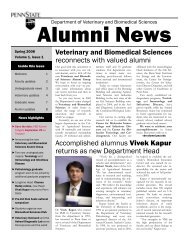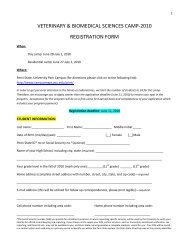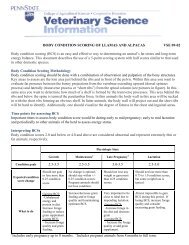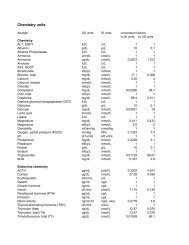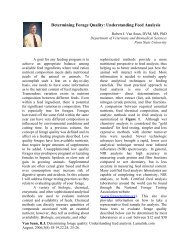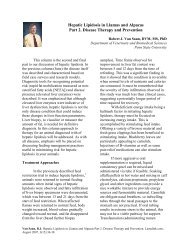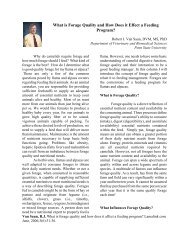Making Sense of Vitamin and Mineral Supplements - Veterinary and ...
Making Sense of Vitamin and Mineral Supplements - Veterinary and ...
Making Sense of Vitamin and Mineral Supplements - Veterinary and ...
Create successful ePaper yourself
Turn your PDF publications into a flip-book with our unique Google optimized e-Paper software.
Take Home Messages:<br />
<strong>Making</strong> <strong>Sense</strong> <strong>of</strong> <strong>Vitamin</strong> <strong>and</strong> <strong>Mineral</strong> <strong>Supplements</strong><br />
Robert J. Van Saun, DVM, MS, PhD<br />
Department <strong>of</strong> <strong>Veterinary</strong> Science<br />
Penn State University<br />
$ <strong>Supplements</strong> are needed to balance daily nutrient needs not met by forages<br />
$ Supplement feeds usually contain trace minerals <strong>and</strong> vitamins, but may also contain variable<br />
amounts <strong>of</strong> energy, protein <strong>and</strong> fiber<br />
$ Feed tag information can be useful to discriminate between products<br />
$ Nutrient content <strong>and</strong> intake amount determines net nutrient delivery from a given supplement<br />
$ <strong>Supplements</strong> vary tremendously in their nutrient delivery <strong>and</strong> they must be appropriately<br />
matched to the forage feeding program<br />
Forage Quality <strong>and</strong> Need for <strong>Supplements</strong><br />
Forages are the foundation <strong>of</strong> an alpaca’s nutritional program. Unfortunately, forages are<br />
most variable in nutrient composition as a result <strong>of</strong> various factors influencing their composition<br />
(i.e., plant species, stage <strong>of</strong> growth, soil fertility, management practices). A survey from Kansas<br />
State University reported forage analysis findings from 709 samples obtained from 23 states. 1<br />
These data showed a large proportion <strong>of</strong> the forages were either marginally deficient or deficient<br />
in zinc (77%), selenium (69.5%) <strong>and</strong> copper (66.7%). 1 Most forages grown across the United<br />
States are deficient in zinc (
NRC publication dealing with nutritional requirements <strong>of</strong> New World Camelids. Most<br />
recommendations for feeding NW camelids are extrapolated data from sheep, goats or cattle.<br />
The objective <strong>of</strong> this presentation will be to address producer concerns in how to decide<br />
adequacy <strong>of</strong> dietary supplements available for New World camelids. Characterization <strong>of</strong><br />
commercial supplements will be summarized along with specific examples <strong>of</strong> matching<br />
supplements to forages will be demonstrated.<br />
Why are <strong>Mineral</strong>s <strong>and</strong> <strong>Vitamin</strong>s Needed?<br />
<strong>Mineral</strong>s are inorganic elements classified into two groups, macrominerals or<br />
microminerals (trace minerals), based on daily amounts required. Macrominerals are required in<br />
grams (g) or ounces (oz) per day <strong>and</strong> include calcium (Ca), phosphorus (P), magnesium (Mg),<br />
sodium (Na), chlorine (Cl), potassium (K) <strong>and</strong> sulfur (S). Macrominerals are primarily<br />
responsible for bone structure, osmotic (fluid balance) regulation, nerve conduction <strong>and</strong> acidbase<br />
balance among others. Trace minerals are required in milligrams (mg) per day <strong>and</strong> include<br />
cobalt (Co), copper (Cu), iodine (I), iron (Fe), manganese (Mn), selenium (Se) <strong>and</strong> zinc (Zn).<br />
Trace minerals are indirectly or directly associated with a tremendous variety <strong>of</strong> metabolic<br />
processes. Deficiency diseases affect almost every physiologic function <strong>and</strong> include immune<br />
dysfunction (Cu, Zn, Se); developmental abnormalities (Cu, Mn, I); abortion (Cu, I, Se); retained<br />
placenta (Cu, Se, I); <strong>and</strong> metabolic disturbances (Co, Fe, Zn, I).<br />
<strong>Vitamin</strong>s are organic compounds that cannot be synthesized by the body to meet needs<br />
<strong>and</strong> function as c<strong>of</strong>actors in nearly all metabolic processes. <strong>Vitamin</strong>s are generally classified as<br />
either fat or water-soluble. Many different compounds may have similar biologic activity<br />
defined for a given vitamin. Therefore, vitamins are not measured by weight like other nutrients,<br />
but rather by comparative biologic activity. <strong>Vitamin</strong> activity or potency is measured in<br />
international units (IU) <strong>and</strong> quantified by some defined st<strong>and</strong>ard. For example, 1 IU <strong>of</strong> vitamin<br />
A activity is defined as the amount <strong>of</strong> vitamin A activity from 0.3 :g retinol (vitamin A alcohol).<br />
Fat-soluble vitamins, namely vitamins A, D <strong>and</strong> E, are the most important for camelids<br />
<strong>and</strong> should be supplemented in the diet, especially a hay-based diet. <strong>Vitamin</strong>s A <strong>and</strong> E will be<br />
adequately ingested if llamas <strong>and</strong> alpacas are grazing on fresh pasture. However, when fed<br />
stored, sun-cured hay, vitamins A <strong>and</strong> E may be insufficient. In contrast, vitamin D is very low<br />
in pasture but is higher in sun-cured forages although possibly not high enough to meet needs<br />
without supplementation.<br />
<strong>Vitamin</strong> E is an antioxidant, which works in concert with selenium in protecting the cell<br />
from oxidative damage <strong>and</strong> modulates immune function. <strong>Vitamin</strong> A is also an antioxidant, but<br />
has many additional metabolic functions including maintaining normal epithelial development<br />
<strong>and</strong> health, bone remodeling, vision <strong>and</strong> immune function. <strong>Vitamin</strong> D is a critical nutrient for<br />
calcium <strong>and</strong> phosphorus balance <strong>and</strong> bone development. <strong>Vitamin</strong> D deficiency has been<br />
implicated in a hypophosphatemic rickets syndrome <strong>of</strong> young growing crias. 3<br />
<strong>Vitamin</strong>s A, D <strong>and</strong> E all play important roles in growth <strong>and</strong> development <strong>of</strong> the cria.<br />
Based on information from other ruminant species <strong>and</strong> preliminary data in llamas <strong>and</strong> alpacas,<br />
these fat-soluble vitamins do not cross the placenta but are transferred very efficiently into
colostrum <strong>and</strong> to a lesser extent into milk. As a result, crias are born with very low<br />
concentrations <strong>of</strong> vitamins A, D <strong>and</strong> E. Consumption <strong>of</strong> colostrum by the cria will be the<br />
primary source <strong>of</strong> these essential vitamins, assuming the dam was adequately supplemented. If<br />
dietary vitamin levels are inadequate, parenteral (injectable) supplementation may be necessary<br />
to maintain proper health <strong>and</strong> growth <strong>of</strong> the cria. Pregnant llamas <strong>and</strong> alpacas can be<br />
supplemented orally or parenterally in late gestation (
Table 1. Suggested dietary macro- <strong>and</strong> micromineral concentrations for camelids based on<br />
sheep <strong>and</strong> cattle data <strong>and</strong> adjusted for reduced dry matter intake. Lower values<br />
would be for maintenance adult animals <strong>and</strong> higher values for growing <strong>and</strong><br />
lactating animals.<br />
Macromineral Requirement<br />
% DM<br />
Micromineral Requirement<br />
ppm<br />
Calcium 0.2 - 0.85 Copper 8 - 11.3<br />
Phosphorus 0.16 - 0.40 Cobalt 0.11 - 0.15<br />
Magnesium 0.12 - 0.20* Iron 53 - 60<br />
Potassium 0.5 - 0.8 Iodine 0.13 - 1.0<br />
Sodium 0.09 - 0.20 Manganese 43 - 47<br />
Chloride 0.15 - 0.25 Selenium 0.4 - 0.6<br />
Sulfur 0.14 - 0.26 Zinc 40 - 47<br />
Fat-soluble <strong>Vitamin</strong>s IU/kg Feed Dry Matter IU/day +<br />
<strong>Vitamin</strong> A 3,000 - 3,300 1,800 - 3,500<br />
<strong>Vitamin</strong> D 1,500 - 2,000 1,050 - 1,650<br />
<strong>Vitamin</strong> E 17 - 33 25 - 33<br />
*May need to be increased (.25 - .35%) if forages containing high amounts <strong>of</strong> potassium (>1.5%)<br />
are being fed.<br />
+Range in intake for 80 lb <strong>and</strong> 165 lb animal at maintenance.<br />
Evaluating Supplement Adequacy<br />
The ideal supplement would be one that is readily consumed (palatable), has a nutrient<br />
content to complement the forage program <strong>and</strong> is consumed at a rate sufficient to meet the<br />
desired intake <strong>of</strong> all nutrients. Most supplements are purchased on the basis <strong>of</strong> word <strong>of</strong> mouth<br />
from other producers, based on their experience, or whatever is available at the local feed store.<br />
Given that your animal’s health <strong>and</strong> productivity <strong>and</strong> farm pr<strong>of</strong>itability are dependent upon the<br />
nutrition program, one needs to obtain as much information about a particular product as<br />
possible. There are a number <strong>of</strong> methods that can be used to evaluate appropriateness <strong>of</strong> a<br />
supplement for your feeding program. These include test feeding for palatability to determine<br />
level <strong>of</strong> acceptance; interpreting <strong>and</strong> comparing feed tag information; calculations <strong>of</strong> nutrient<br />
delivery compared to requirements <strong>and</strong> determinations <strong>of</strong> nutrient balance between forage <strong>and</strong><br />
supplement compared to desired dietary nutrient density.<br />
Feed Tag Interpretation. <strong>Supplements</strong> vary tremendously in their nutrient content.<br />
Some <strong>of</strong> this variation is intentional relative to the designed purpose <strong>of</strong> the product. <strong>Mineral</strong>
supplements are usually salt-based, to limit intake, <strong>and</strong> then contain variable concentrations <strong>of</strong><br />
trace minerals <strong>and</strong> possibly fat-soluble vitamins. These are your classic trace mineral salt<br />
products, which are typically fed free-choice. Complete mineral products will also contain<br />
calcium, phosphorus <strong>and</strong> other macrominerals. These products may be free choice or designed<br />
to be fed at a defined rate. Other supplements will contain energy <strong>and</strong> protein sources <strong>and</strong> are<br />
identified as “complete grains or supplements”. This means the supplement contains all other<br />
nutrients needed to complement the forage being fed. Expected intake for these products will<br />
vary according to formulated nutrient density.<br />
Feed tags on commercial products are required by state law to provide designated<br />
information about the product. This includes feed name, purpose, feeding directions,<br />
manufacturer’s address, guaranteed analysis, list <strong>of</strong> ingredients, medications (if present) <strong>and</strong><br />
withdrawl time (if medicated). The required guaranteed analysis provides limited analyses,<br />
usually crude protein, crude fiber, crude fat, calcium, phosphorus <strong>and</strong> possibly salt <strong>and</strong> ash.<br />
Other product literature may be available with more details <strong>and</strong> some companies will provide<br />
more detailed information on their feed tags. Feed tag information generally does not provide<br />
you energy content. Guaranteed analysis values are on an as fed basis <strong>and</strong> not dry matter.<br />
Reviewing the ingredient list on the feed tag can provide some insight as to potential<br />
energy sources. Ingredients like corn, oats <strong>and</strong> barley will provide much carbohydrate for<br />
energy. Fiber sources, which can provide some energy, include wheat middlings, wheat bran,<br />
soybean hulls, cottonseed hulls or forage products (generic by-product term). Protein sources<br />
will include primarily soybean, canola or corn gluten meals. The first 3 ingredients generally set<br />
the trend for the product. To really have a good underst<strong>and</strong>ing <strong>of</strong> what a particular supplement<br />
product contains, one needs to have a sample analyzed for nutrient content through a certified<br />
feed analysis laboratory. Ideally, forage should also be sampled for nutrient content for best<br />
evaluation, but averaged nutrient content from tables can be used as a guide. If forage testing is<br />
not completed, one should err on the higher side for desired nutrient delivery from supplements.<br />
As for mineral supplementation sources, inorganic sources from sulfate <strong>and</strong> carbonate<br />
forms are usually more bioavailable than the oxide forms. Review the list <strong>of</strong> ingredients to see<br />
what mineral sources are being used. Organic forms <strong>of</strong> minerals are protected from pregastric<br />
alteration <strong>and</strong> generally are considered highly available. However, there is more than one form<br />
<strong>of</strong> organic minerals <strong>and</strong> not all forms result in positive supplementation responses. Overall,<br />
organic forms <strong>of</strong> minerals are more expensive than their inorganic counterparts. Organic forms<br />
are best used in situations <strong>of</strong> stress or reduced intake capacity. A good example is zinc.<br />
Clinically there seems to be a zinc-responsive dermatosis problem with domesticated camelids.<br />
Improvements in the condition have been observed when zinc methionine (ZinPro®) has been<br />
supplemented. 6<br />
Other ingredients may also be included in a supplement. Generally these are stabilizers,<br />
preservatives <strong>and</strong> feed additives. Typical additives may include yeast cultures or yeast extract,<br />
probiotic products, various B-vitamins, yucca <strong>and</strong> many other substances. Data to support the<br />
incorporation <strong>of</strong> many <strong>of</strong> these feed additives is very limited. As with other ruminants, it is<br />
hypothesized that all necessary B-vitamins (water-soluble) are synthesized by bacteria in the<br />
forestomach <strong>and</strong> therefore are not required in the diet. However, under certain stress conditions
or fermentation disorders, B-vitamin supplementation may be beneficial. Yeast products have<br />
been shown to have a positive effect on rumen fermentation, intake <strong>and</strong> resistance to heat stress<br />
in cattle. Similar positive responses may be applicable to camelids. <strong>Supplements</strong> should not be<br />
purchased solely on the basis <strong>of</strong> whether or not these additive products are included.<br />
Nutrient Delivery Calculations. Another aspect <strong>of</strong> evaluating a supplement is<br />
determining the amount <strong>of</strong> nutrient delivered relative to animal requirements. For this you need<br />
to be able to interpret <strong>and</strong> use the information presented on the product feed tag. The difficult<br />
part here is interpreting <strong>and</strong> comparing nutrient concentrations <strong>of</strong> differing products based on<br />
label information. You need to compare “apples with apples”; therefore, you must carefully read<br />
label information <strong>and</strong> convert information to a equivalent basis for comparison. For example,<br />
nutrient content <strong>of</strong> a product may be presented on a per pound basis, per ounce basis or per dose<br />
basis. These are not necessarily the same for all products. Nutrient content may be presented as<br />
a percent or part per million (ppm). Table 2 provides some basic conversion factors helpful in<br />
comparing <strong>and</strong> using label nutrient values.<br />
One method would be to calculate total amount <strong>of</strong> a given nutrient that would be<br />
consumed from the supplement <strong>and</strong> then compare this value to extrapolated nutrient<br />
requirements. This can be easily accomplished for selenium as we usually provide all dietary<br />
selenium from a supplement. Using Table 3, we can determine that mineral products must have<br />
90 to 120 ppm selenium to meet daily selenium needs (1 mg/day for adults) at an expected intake<br />
<strong>of</strong> 0.25 to 0.33 oz/day. Or to consume 1 mg selenium, a pellet must contain between 4 <strong>and</strong> 8<br />
ppm selenium in order to feed less than 1 lb <strong>of</strong> supplement. For other nutrients, multiply amount<br />
fed (as fed or dry matter basis) times nutrient content (as fed or dry matter basis, respectively). If<br />
your supplement meets each <strong>of</strong> these nutrient requirements without accounting for the forage,<br />
then you can assume the<br />
supplement is adequate. If<br />
the supplement does not<br />
meet the suggested<br />
requirement, then<br />
determine if sufficient<br />
amounts <strong>of</strong> the nutrient in<br />
question are available from<br />
the forage. In general,<br />
forages provide very little<br />
additional trace minerals,<br />
except for iron <strong>and</strong><br />
manganese. This method<br />
requires a fair amount <strong>of</strong><br />
calculations <strong>and</strong> this<br />
process could be greatly<br />
enhanced by using a<br />
computer spreadsheet.<br />
Table 2. Common nutritional conversion factors.<br />
Units Given Units Wanted Conversion<br />
oz grams multiply by 28.4<br />
lb grams multiply by 454<br />
lb oz divide by 16<br />
grams mg move decimal to right 3 places<br />
mg grams move decimal to left 3 places<br />
mg :g<br />
move decimal to right 3 places<br />
mg/kg ppm same value<br />
mg/kg mg/lb multiply by 0.454<br />
mg/kg (ppm) % move decimal to left 4 places<br />
% mg/kg (ppm)<br />
move decimal to right 4 places<br />
Table 2. Common nutritional conversion factors.
Table 3. Calculated amounts <strong>of</strong> either selenium intake (A) or selenium-fortified<br />
supplement (B) needed to achieve specified levels <strong>of</strong> selenium intake.<br />
A. Free Choice <strong>Mineral</strong> <strong>Supplements</strong><br />
Selenium<br />
(ppm)<br />
Daily Salt Intake (oz)<br />
0.25 0.33 0.5 1.0 1.25<br />
30 0.21 0.28 0.4 0.85 1.1<br />
50 0.35 0.47 0.7 1.4 1.8<br />
90 0.64 0.84 1.3 2.6 3.2<br />
120 0.85 1.12 1.7 3.4 4.25<br />
B. Selenium Containing <strong>Supplements</strong><br />
Desired<br />
Selenium<br />
Intake<br />
Supplement Selenium Concentration (ppm)<br />
0.3 1.0 2.0 4.0 8.0<br />
mg/day lbs supplement needed to be consumed per day<br />
0.5 3.7 1.1 0.6 0.3 0.15<br />
1.0 7.3 2.2 1.1 0.55 0.27<br />
1.5 11.0 3.3 1.7 0.85 0.43<br />
2.0 14.7 4.4 2.2 1.1 0..55<br />
2.5 18.4 5.5 2.8 1.4 0.7<br />
Supplement-Forage Compatibility. The second step in evaluating supplement adequacy<br />
is to determine how well the supplement nutrient pr<strong>of</strong>ile complements the forage nutrient pr<strong>of</strong>ile.<br />
A method <strong>of</strong> assessing nutritional compatibility between a supplement <strong>and</strong> forage is to use a<br />
Pearson Square calculation method. The Pearson Square is a method used to determine how to<br />
combine two feed products to achieve a desired nutrient content. For the example shown (Figure<br />
1), you would need to feed 94% grass hay with 6% pellet to balance the diet for zinc. In<br />
contrast, you need to feed 82% grass hay <strong>and</strong> 18% pellet to balance the diet for copper. To put<br />
this in better perspective, if the animal will consume 1.5% <strong>of</strong> body weight, then 6% <strong>of</strong> 1.5% (1.5<br />
x 0.06 = 0.09%) requires the pellet to be fed at 0.09 % <strong>of</strong> body weight or 0.09 lb per 100 lb <strong>of</strong><br />
body weight. If the feeding directions suggest feeding at 0.3 lb per 100 lb <strong>of</strong> body weight, then<br />
this product will be more than adequate in supplying zinc. The same calculation for<br />
copper would show that 0.27 lb per 100 lb <strong>of</strong> body weight (1.5 x 0.18 = 0.27) must be fed. In<br />
comparing results, the pellet provides far more zinc at suggested feeding rate <strong>and</strong> just enough<br />
copper. This calculation can be completed for any or all nutrients to assess adequacy <strong>of</strong> a<br />
supplement.
Figure 1. Nutritional evaluation <strong>of</strong> supplements using a Pearson square. Box center (A)<br />
contains desired nutrient content <strong>of</strong> diet. Left side <strong>of</strong> box (B) has nutrient content<br />
<strong>of</strong> two different feeds to be blended together to meet requirement. Values on<br />
right side <strong>of</strong> box (C) represent differences across diagonal lines (absolute values).<br />
These values are summed (D) <strong>and</strong> percent contribution for each feed calculated.<br />
In the example, the diet would need to be 94% or 82% grass hay <strong>and</strong> 6% or 18%<br />
pellet based on calculations to meet zinc <strong>and</strong> copper requirements, respectively.<br />
B C<br />
Grass Hay<br />
20 mg/kg Zn<br />
8 mg/kg Cu<br />
Pellet<br />
500 mg/kg Zn<br />
25 mg/kg Cu<br />
A<br />
Zinc: 50 mg/kg<br />
Copper: 11 mg/kg<br />
450 Zn 94 % Zn<br />
14 Cu 82 % Cu<br />
30 Zn 6% Zn<br />
3 Cu 18% Cu<br />
480 Zn<br />
17 Cu<br />
Feeding Trial. Once you have determined whether or not a given supplement will<br />
deliver the appropriate amount <strong>of</strong> nutrients <strong>and</strong> is balanced with your forage, you need to<br />
determine if your animals will consume the product at an appropriate level <strong>of</strong> intake.<br />
Remember, nutrient delivery on a daily basis is the product <strong>of</strong> supplement nutrient concentration<br />
times intake amount.<br />
Expected intake <strong>and</strong> nutrient delivery is a confounding problem with feeding<br />
supplements. Most products are designed to be fed similar to other domestic species. For pellet<br />
products, most intake expectations are fairly reasonable at 0.3 to 0.5 lb/day. However, others<br />
expect more than 1 lb/day intake, which would be nearly 40% <strong>of</strong> the diet as supplement. Many<br />
people would not feed that much <strong>and</strong> certainly not to overweight animals. If intake <strong>of</strong> these<br />
products is less than recommended, then overall nutrient intake will be lower; possibly<br />
insufficient to meet needs. This concern is a more critical issue for mineral products. The<br />
expected intake <strong>of</strong> most <strong>of</strong> these products is 0.5 oz/day up to 2 oz/day. Practical feeding<br />
experience suggests, at best, free-choice salt-based mineral intake <strong>of</strong> 0.25 - 0.33 oz/day. If this is<br />
what you observe with your animals, then the calculated nutrient amounts in Table 4 need to be<br />
D
educed by 1/4 or 1/3 to account for the lower intake. This opens the door for even more<br />
potential problems with inadequate nutrient intake using these products.<br />
Table 4. Comparison <strong>of</strong> calculated mean, minimum <strong>and</strong> maximum daily nutrient intake for<br />
17 pellet supplement <strong>and</strong> 11 free-choice vitamin-mineral salt products routinely<br />
fed to camelids.<br />
Nutrient<br />
Content<br />
Require<br />
ment*<br />
Pellet Products <strong>Vitamin</strong>-<strong>Mineral</strong> Salt Products<br />
Mean Low High Mean Low High<br />
Expected Intake 2.25 lb 0.66 lb/d 0.25 1.5 1.46 oz/d 0.5 2<br />
Crude Protein, gm 105.5 41.1 12.5 96.0<br />
Calcium, gm 4.1 4.2 1.6 9.7 2.7 1.1 6.5<br />
Phosphorus, gm 2.4 2.7 1.0 6.0 1.8 0.6 8.0<br />
Magnesium, gm 1.5 1.4 0.47 2.5 0.23 0 0.96<br />
Potassium, gm 10.2 3.1 1.5 5.6 0.4 0 0.85<br />
Salt, gm 5.6 3.3 1.0 5.4 6.4 0.8 11.9<br />
Cobalt, mg 0.27 1.1 0.14 3.0 0.49 0.26 1.49<br />
Copper, mg 11.5 12.5 2.0 68.1 4.7 0.4 9.9<br />
Iodine, mg 1.0 7.6 0.03 54.5 1.2 0.4 6.0<br />
Iron, mg 51 117 11.4 274.7 98.5 14.9 300<br />
Manganese, mg 48 93.1 17.4 272.4 69.6 6.4 199.8<br />
Selenium, mg .6 - 1.0 1.0 0.15 2.25 1.1 0.28 2.55<br />
Zinc, mg 48 112 25.5 326.9 152 99.3 255.9<br />
<strong>Vitamin</strong> A, IU 3,375 7,826 2,954 15,000 8,391 4,951 12,500<br />
<strong>Vitamin</strong> D, IU 2,045 1,900 500 5,300 1,469 586 3,125<br />
<strong>Vitamin</strong> E, IU 33.75 172 10.5 400 92.1 11.7 219<br />
*Based on extrapolated requirements for pregnant female weighing 150 lbs (68.2 kg) consuming<br />
dry matter at 1.5% <strong>of</strong> body weight.<br />
Supplement Comparisons<br />
In recognizing nutrient variability in forages <strong>and</strong> addressing consumer dem<strong>and</strong>, feed<br />
manufacturers in North America have produced a variety <strong>of</strong> supplements for llamas <strong>and</strong> alpacas.<br />
From feed tag data, it can be seen there is tremendous range in nutrient content across products.<br />
Part <strong>of</strong> this variation can be attributed to differences in expected intake <strong>of</strong> the pellet or mineral.<br />
To better compare supplements, amounts <strong>of</strong> each nutrient were determined for a defined animal
(Table 4). Free-choice mineral intake calculations were based on the expected intake taken from<br />
the feed tag. In simply comparing nutrient amounts delivered to suggested nutrient<br />
requirements, mean nutrient amounts across products meet or exceed needs. However, there is<br />
still much range in nutrient delivery; in some cases more than 20-fold differences. As already<br />
addressed, specific nutrient requirements <strong>of</strong> camelids have not been defined. As a result, most<br />
commercial camelid supplements mimic current products for sheep, cattle, horses or some<br />
variation on the theme. Nutrient content <strong>of</strong> many supplements does not account for variation in<br />
forage nutrient content, let alone whether grass or legume forages are being fed.<br />
Using the calculation <strong>and</strong> comparison method, none <strong>of</strong> the mineral supplements <strong>and</strong> 7 <strong>of</strong><br />
17 pellet supplements provide sufficient copper. This may be the result <strong>of</strong> concern over potential<br />
copper toxicity problems, which at present is undefined in camelids. Only 50% <strong>of</strong> mineral<br />
supplements provide sufficient selenium; however, if intake is reduced to more reasonable<br />
intake, none will be adequate. Approximately one-half (8 <strong>of</strong> 17) <strong>of</strong> the pellet supplements<br />
provide sufficient selenium. Iron is sufficient in 67% <strong>of</strong> mineral <strong>and</strong> pellet supplements.<br />
<strong>Vitamin</strong>s A <strong>and</strong> E are generally adequately supplemented with either product. Zinc is adequate<br />
in all mineral <strong>and</strong> 10 <strong>of</strong> 12 pellet supplements, but would be a problem if mineral intake was<br />
lower than expected. Of concern is only 25% <strong>of</strong> all supplements meet vitamin D requirements.<br />
Summary<br />
To maintain high expected productivity <strong>and</strong> health in your animals, supplement feeding<br />
over-<strong>and</strong>-above your forage program will be necessary. The question then becomes: “Which<br />
supplement best fits my needs?” Unfortunately there is no one simple answer. <strong>Supplements</strong><br />
must be balanced to the prevailing forage feeding program. Ultimately, one needs to match<br />
nutrient delivery (intake x content) from forage <strong>and</strong> supplement to defined animal requirement.<br />
However, there are no currently accepted guidelines for nutrient requirements in camelids. As a<br />
result, owners are left in a state <strong>of</strong> confusion as to whether or not their supplement is adequate.<br />
Information presented can be helpful in making a more informed decision in feeding<br />
supplements. Owners are encouraged to work with their attending veterinarians in monitoring<br />
animal performance <strong>and</strong> nutritional status as a method to determine adequacy <strong>of</strong> their<br />
supplement feeding program.
References:<br />
1. Mortimer, R.G.; D.A. Dargatz <strong>and</strong> L.R. Corah. Forage Analyses from Cow-calf Herds in 23<br />
States. USDA:APHIS:VS, Centers for Epidemiology <strong>and</strong> Animal Health, Fort Collins, CO.,<br />
#N303.499, April 1999.<br />
2. Dart, A.J.; H. Kinde; D.R. Hodgson; J.R. Peauroi; A.W. Selby; J. Maas <strong>and</strong> M.E. Fowler.<br />
Serum "-tocopherol, vitamin A, <strong>and</strong> blood selenium concentrations, <strong>and</strong> glutathione<br />
peroxidase activity in llamas fed alfalfa hay. Am J Vet Res 57(5):689-692, 1996.<br />
3. Van Saun, R.J.; B.B. Smith <strong>and</strong> B.J. Watrous: Evaluation <strong>of</strong> vitamin D status <strong>of</strong> llamas <strong>and</strong><br />
alpacas with hypophosphatemic rickets. J Am Vet Med Assoc 209(6):1128-1133, 1996.<br />
4. Van Saun, R.J. Chapter 9. Diet, In: H<strong>of</strong>fman, E (ed.), The Complete Alpaca Book, 2 nd ed.,<br />
Bonny Doon Press: Santa Cruz, CA, 2003.<br />
5. Smith, B.B., R.J. Van Saun. Hypophosphatemic rickets in South American camelids:<br />
Interaction <strong>of</strong> calcium, phosphorus, <strong>and</strong> vitamin D. In: Proceedings 2 nd European<br />
Symposium on South American Camelids, Gerken, M <strong>and</strong> C. Renieri, eds., Universita Degli<br />
Studi Di Camerino, Italy, pp. 79-94, 1996.<br />
6. Johnson, L.W. Llama Nutrition. Vet Clinics <strong>of</strong> NA: Food Animal Practice 10(2):187-201,<br />
1994.




